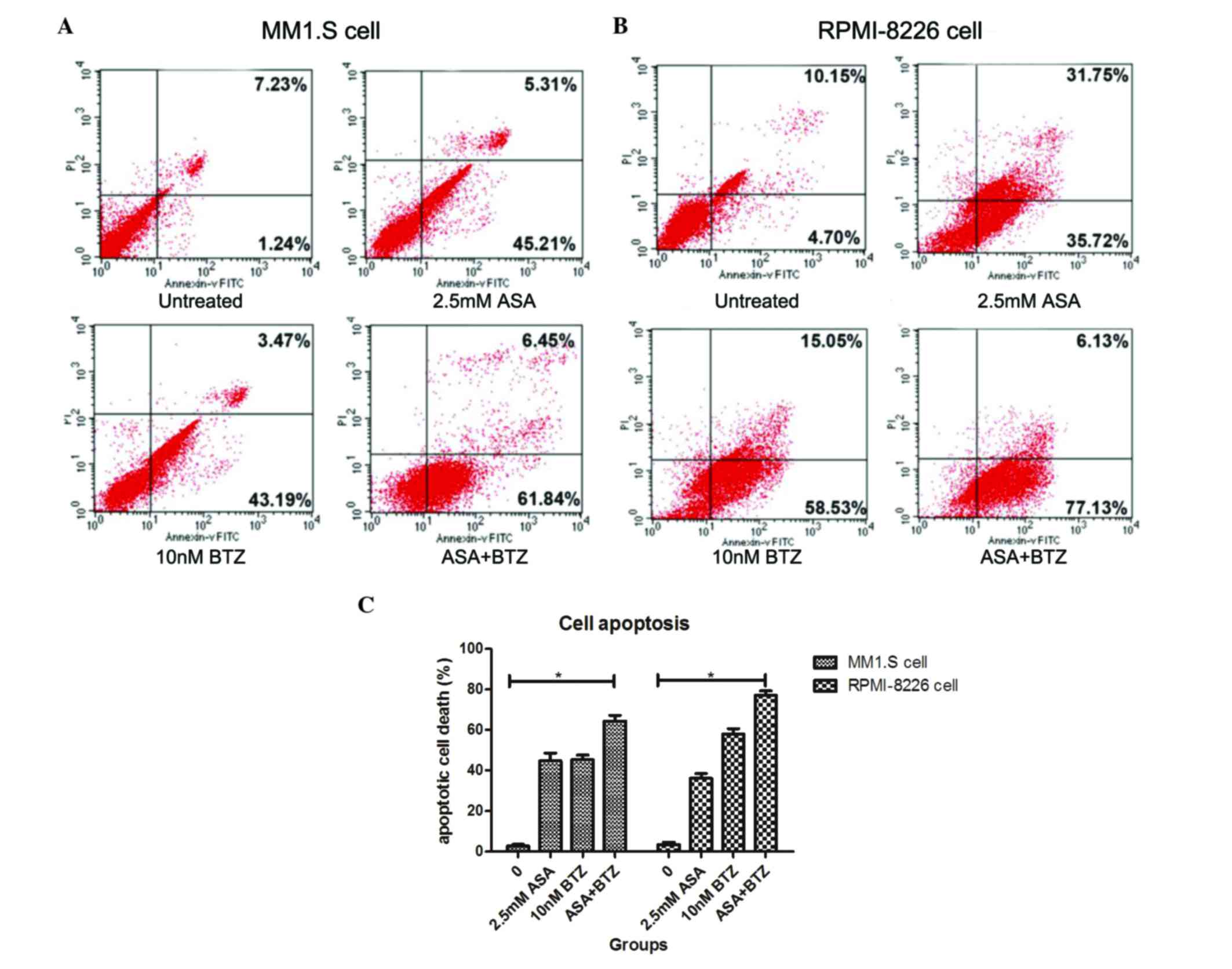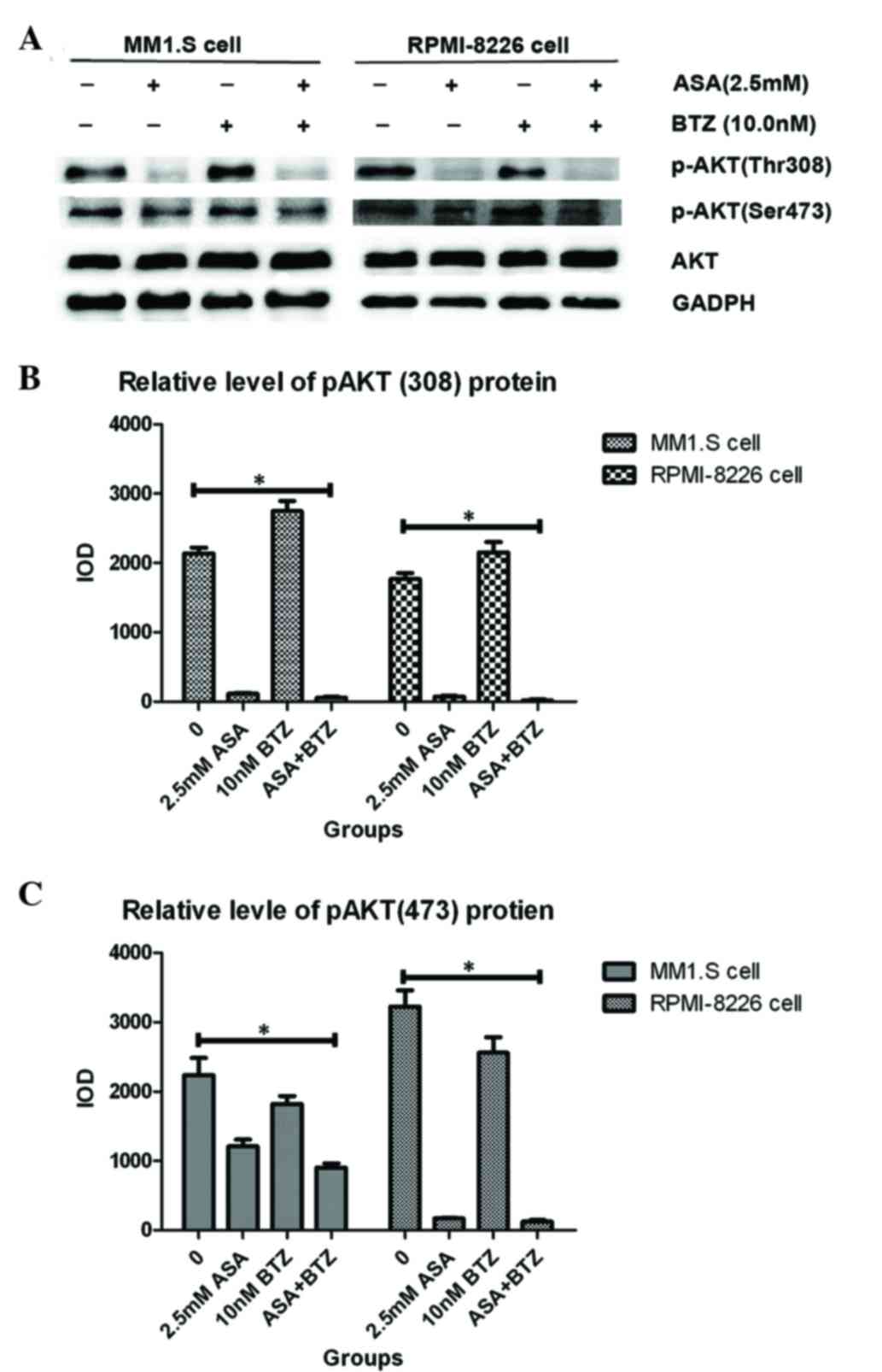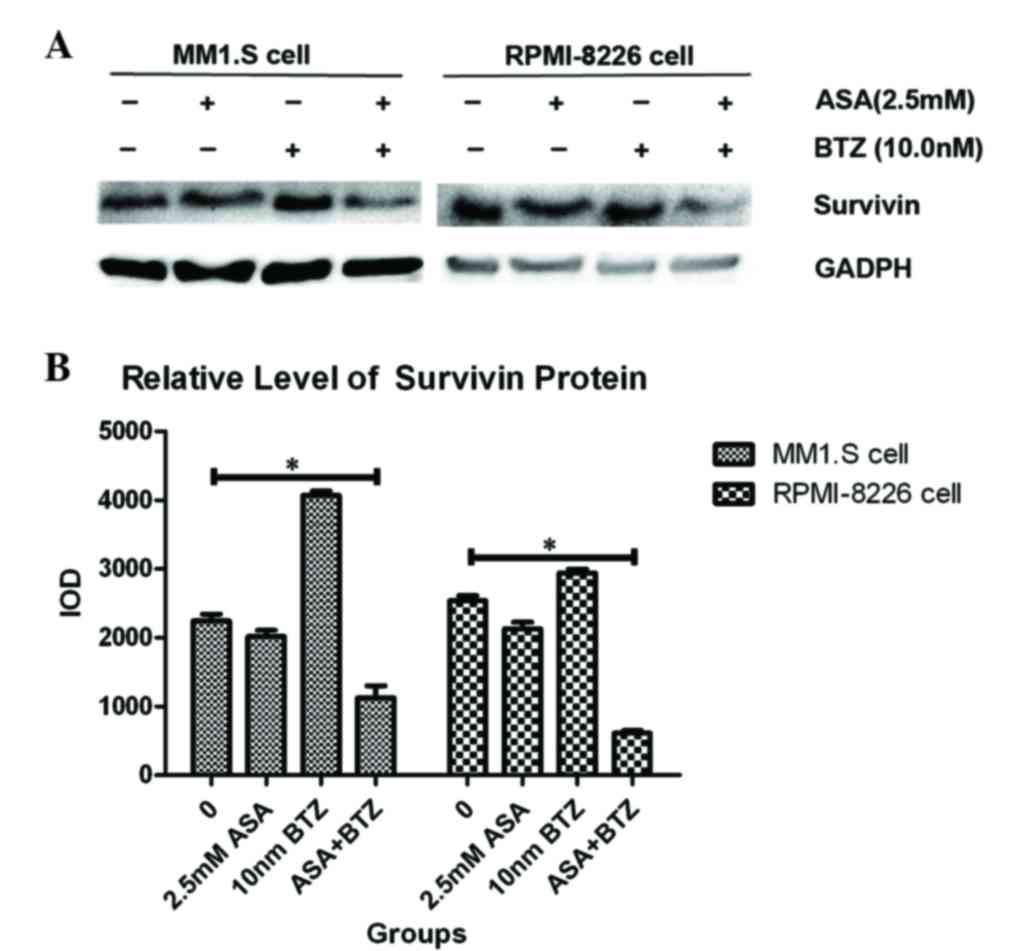|
1
|
Siegel R, Ma J, Zou Z and Jemal A: Cancer
statistics, 2014. CA Cancer J Clin. 64:9–29. 2014. View Article : Google Scholar : PubMed/NCBI
|
|
2
|
Chen W, Zheng R, Baade PD, Zhang S, Zeng
H, Bray F, Jemal A, Yu XQ and He J: Cancer statistics in China,
2015. CA Cancer J Clin. 66:115–132. 2016. View Article : Google Scholar : PubMed/NCBI
|
|
3
|
Sonneveld P and Broijl A: Treatment of
relapsed and refractory multiple myeloma. Haematologica.
101:9952016. View Article : Google Scholar : PubMed/NCBI
|
|
4
|
Morgan GJ and Davies FE: Role of
thalidomide in the treatment of patients with multiple myeloma.
Crit Rev Oncol Hematol. 1(88): Supp 1. S14–S22. 2013. View Article : Google Scholar
|
|
5
|
Bagratuni T, Kastritis E, Politou M,
Roussou M, Kostouros E, Gavriatopoulou M, Eleutherakis-Papaiakovou
E, Kanelias N, Terpos E and Dimopoulos MA: Clinical and genetic
factors associated with venous thromboembolism in myeloma patients
treated with lenalidomide-based regimens. Am J Hematol. 88:765–770.
2013. View Article : Google Scholar : PubMed/NCBI
|
|
6
|
Palumbo A, Cavo M, Bringhen S, Zamagni E,
Romano A, Patriarca F, Rossi D, Gentilini F, Crippa C, Galli M, et
al: Aspirin, warfarin, or enoxaparin thromboprophylaxis in patients
with multiple myeloma treated with thalidomide: A phase III,
open-label, randomized trial. J Clin Oncol. 29:986–993. 2011.
View Article : Google Scholar : PubMed/NCBI
|
|
7
|
Niesvizky R, Martínez-Baños D,
Jalbrzikowski J, Christos P, Furst J, De Sancho M, Mark T, Pearse
R, Mazumdar M, Zafar F, et al: Prophylactic low-dose aspirin is
effective antithrombotic therapy for combination treatments of
thalidomide or lenalidomide in myeloma. Leuk Lymphoma.
48:2330–2337. 2007. View Article : Google Scholar : PubMed/NCBI
|
|
8
|
Araujo JL, Altorki NK, Sonett JR,
Rodriguez A, Sungur-Stasik K, Spinelli CF, Neugut AI and Abrams JA:
Prediagnosis aspirin use and outcomes in a prospective cohort of
esophageal cancer patients. Therap Adv Gastroenterol. 9:806–814.
View Article : Google Scholar : PubMed/NCBI
|
|
9
|
Murphy C, Turner N, Wong HL, Sinnathamby
M, Tie J, Lee B, Desai J, Skinner I, Christie M and Hutchinson R:
Examining the impact of regular aspirin use and PIK3CA mutations on
survival in stage 2 colon cancer. Intern Med J. Nov 1–2016.(Epub
ahead of print). PubMed/NCBI
|
|
10
|
Hochmuth F, Jochem M and Schlattmann P:
Meta-analysis of aspirin use and risk of lung cancer shows notable
results. Eur J Cancer Prev. 25:259–268. 2016. View Article : Google Scholar : PubMed/NCBI
|
|
11
|
Bradley MC, Black A, Freedman AN and
Barron TI: Prediagnostic aspirin use and mortality in women with
stage I to III breast cancer: A cohort study in the Prostate, Lung,
Colorectal, and Ovarian Cancer Screening Trial. Cancer.
122:2067–2075. 2016. View Article : Google Scholar : PubMed/NCBI
|
|
12
|
Kim YI, Kim SY, Kim JH, Lee JH, Kim YW,
Ryu KW, Park JH and Choi IJ: Long-term low-dose aspirin use reduces
gastric cancer incidence: A nationwide cohort study. Cancer Res
Treat. 48:798–805. 2016. View Article : Google Scholar : PubMed/NCBI
|
|
13
|
Xiang S, Sun Z, He Q, Yan F, Wang Y and
Zhang J: Aspirin inhibits ErbB2 to induce apoptosis in cervical
cancer cells. Med Oncol. 27:379–387. 2010. View Article : Google Scholar : PubMed/NCBI
|
|
14
|
Park IS, Jo JR, Hong H, Nam KY, Kim JB,
Hwang SH, Choi MS, Ryu NH, Jang HJ, Lee SH, et al: Aspirin induces
apoptosis in YD-8 human oral squamous carcinoma cells through
activation of caspases, down-regulation of Mcl-1, and inactivation
of ERK-1/2 and AKT. Toxicol In Vitro. 24:713–720. 2010. View Article : Google Scholar : PubMed/NCBI
|
|
15
|
Ararat E, Sahin I and Altundag K:
Mechanisms behind the aspirin use and decreased breast cancer
incidence. J BUON. 16:1802011.PubMed/NCBI
|
|
16
|
Im SR and Jang YJ: Aspirin enhances
TRAIL-induced apoptosis via regulation of ERK1/2 activation in
human cervical cancer cells. Biochem Biophys Res Commun. 424:65–70.
2012. View Article : Google Scholar : PubMed/NCBI
|
|
17
|
Lim WY, Chuah KL, Eng P, Leong SS, Lim E,
Lim TK, Ng A, Poh WT, Tee A, Teh M, et al: Aspirin and non-aspirin
non-steroidal anti-inflammatory drug use and risk of lung cancer.
Lung Cancer. 77:246–251. 2012. View Article : Google Scholar : PubMed/NCBI
|
|
18
|
Ding JH, Yuan LY, Huang RB and Chen GA:
Aspirin inhibits proliferation and induces apoptosis of multiple
myeloma cells through regulation of Bcl-2 and Bax and suppression
of VEGF. Eur J Haematol. 93:329–339. 2014. View Article : Google Scholar : PubMed/NCBI
|
|
19
|
Chen D, Frezza M, Schmitt S, Kanwar J and
Dou QP: Bortezomib as the first proteasome inhibitor anticancer
drug: Current status and future perspectives. Curr Cancer Drug
Targets. 11:239–253. 2011. View Article : Google Scholar : PubMed/NCBI
|
|
20
|
Chauhan D, Tian Z, Nicholson B, Kumar KG,
Zhou B, Carrasco R, McDermott JL, Leach CA, Fulcinniti M, Kodrasov
MP, et al: A small molecule inhibitor of ubiquitin-specific
protease-7 induces apoptosis in multiple myeloma cells and
overcomes bortezomib resistance. Cancer Cell. 22:345–358. 2012.
View Article : Google Scholar : PubMed/NCBI
|
|
21
|
Oerlemans R, Franke NE, Assaraf YG, Cloos
J, van Zantwijk I, Berkers CR, Scheffer GL, Debipersad K, Vojtekova
K, Lemos C, et al: Molecular basis of bortezomib resistance:
Proteasome subunit beta5 (PSMB5) gene mutation and overexpression
of PSMB5 protein. Blood. 112:2489–2499. 2008. View Article : Google Scholar : PubMed/NCBI
|
|
22
|
Kuhn DJ, Berkova Z, Jones RJ, Woessner R,
Bjorklund CC, Ma W, Davis RE, Lin P, Wang H, Madden TL, et al:
Targeting the insulin-like growth factor-1 receptor to overcome
bortezomib resistance in preclinical models of multiple myeloma.
Blood. 120:3260–3270. 2012. View Article : Google Scholar : PubMed/NCBI
|
|
23
|
Gu JL, Li J, Zhou ZH, Liu JR, Huang BH,
Zheng D and Su C: Differentiation induction enhances bortezomib
efficacy and overcomes drug resistance in multiple myeloma. Biochem
Biophys Res Commun. 420:644–650. 2012. View Article : Google Scholar : PubMed/NCBI
|
|
24
|
Hideshima T, Catley L, Yasui H, Ishitsuka
K, Raje N, Mitsiades C, Podar K, Munshi NC, Chauhan D, Richardson
PG and Anderson KC: Perifosine, an oral bioactive novel
alkylphospholipid, inhibits Akt and induces in vitro and in vivo
cytotoxicity in human multiple myeloma cells. Blood. 107:4053–4062.
2006. View Article : Google Scholar : PubMed/NCBI
|
|
25
|
Uddin S, Ahmed M, Hussain A, Assad L,
Al-Dayel F, Bavi P, Al-Kuraya KS and Munkarah A: Cyclooxygenase-2
inhibition inhibits PI3K/AKT kinase activity in epithelial ovarian
cancer. Int J Cancer. 126:382–394. 2010. View Article : Google Scholar : PubMed/NCBI
|
|
26
|
Yang L, Zhu H, Liu D, Liang S, Xu H, Chen
J, Wang X and Xu Z: Aspirin suppresses growth of human gastric
carcinoma cell by inhibiting survivin expression. J Biomed Res.
25:246–253. 2011. View Article : Google Scholar : PubMed/NCBI
|
|
27
|
Chng WJ, Gonzalez-Paz N, Price-Troska T,
Jacobus S, Rajkumar SV, Oken MM, Kyle RA, Henderson KJ, Van Wier S,
Greipp P, et al: Clinical and biological significance of RAS
mutations in multiple myeloma. Leukemia. 22:2280–2284. 2008.
View Article : Google Scholar : PubMed/NCBI
|
|
28
|
Fischel JL, Formento P and Milano G:
Epidermal growth factor receptor double targeting by a tyrosine
kinase inhibitor (Iressa) and a monoclonal antibody (Cetuximab).
Impact on cell growth and molecular factors. Br J Cancer.
92:1063–1068. 2005. View Article : Google Scholar : PubMed/NCBI
|
|
29
|
Book Review: Goodman and Gilman's the
Pharmacological Basis of Therapeutics. Digital Edition; 11th. 40.
pp. 12182006
|
|
30
|
Terpos E, Roussou M and Dimopoulos MA:
Bortezomib in multiple myeloma. Expert Opin Drug Metab Toxicol.
4:639–654. 2008. View Article : Google Scholar : PubMed/NCBI
|
|
31
|
Harvey RD and Lonial S: PI3 kinase/AKT
pathway as a therapeutic target in multiple myeloma. Future Oncol.
3:639–647. 2007. View Article : Google Scholar : PubMed/NCBI
|
|
32
|
Choe KS and Liauw SL: Effects of aspirin
on cancer initiation and progression. Expert Rev Anticancer Ther.
13:115–117. 2013. View Article : Google Scholar : PubMed/NCBI
|
|
33
|
Wilson JC, Murray LJ, Hughes CM, Black A
and Anderson LA: Non-steroidal anti-inflammatory drug and aspirin
use and the risk of head and neck cancer. Br J Cancer.
108:1178–1181. 2013. View Article : Google Scholar : PubMed/NCBI
|
|
34
|
Rothwell PM: Alternate-day, low-dose
aspirin and cancer risk. Ann Intern Med. 159:148–150. 2013.
View Article : Google Scholar : PubMed/NCBI
|
|
35
|
Jonsson F, Yin L, Lundholm C, Smedby KE,
Czene K and Pawitan Y: Low-dose aspirin use and cancer
characteristics: A population-based cohort study. Br J Cancer.
109:1921–1925. 2013. View Article : Google Scholar : PubMed/NCBI
|
|
36
|
Algra AM and Nortier JW: Aspirin and
cancer: Evidence of a prophylactic effect. Ned Tijdschr Geneeskd.
157:A51892013.(In Dutch). PubMed/NCBI
|
|
37
|
Coutte L, Dreyer C, Sablin MP, Faivre S
and Raymond E: PI3K-AKT-mTOR pathway and cancer. Bull Cancer.
99:173–180. 2012.(In French). PubMed/NCBI
|
|
38
|
Hsu J, Shi Y, Krajewski S, Renner S,
Fisher M, Reed JC, Franke TF and Lichtenstein A: The AKT kinase is
activated in multiple myeloma tumor cells. Blood. 98:2853–2855.
2001. View Article : Google Scholar : PubMed/NCBI
|
|
39
|
Hasson SP, Rubinek T, Ryvo L and Wolf I:
Endocrine resistance in breast cancer: Focus on the
phosphatidylinositol 3-Kinase/Akt/mammalian target of rapamycin
signaling pathway. Breast Care (Basel). 8:248–255. 2013. View Article : Google Scholar : PubMed/NCBI
|
|
40
|
Bi LK, Zhou N, Liu C, Lu FD, Lin TX, Xuan
XJ, Jiang C, Han JL, Huang H, Zhang CX, et al: Kidney cancer cells
secrete IL-8 to activate Akt and promote migration of mesenchymal
stem cells. Urol Oncol. 32:607–612. 2014. View Article : Google Scholar : PubMed/NCBI
|
|
41
|
Ito S, Igishi T, Takata M, Ueda Y,
Matsumoto S, Kodani M, Takeda K, Izumi H, Sakamoto T, Yamaguchi K,
et al: Synergistic cell growth inhibition by the combination of
amrubicin and Akt-suppressing agents in K-ras mutation-harboring
lung adenocarcinoma cells: Implication of EGFR tyrosine kinase
inhibitors. Int J Oncol. 44:685–692. 2014.PubMed/NCBI
|
|
42
|
Steinbrunn T, Stühmer T, Gattenlöhner S,
Rosenwald A, Mottok A, Unzicker C, Einsele H, Chatterjee M and
Bargou RC: Mutated RAS and constitutively activated Akt delineate
distinct oncogenic pathways, which independently contribute to
multiple myeloma cell survival. Blood. 117:1998–2004. 2011.
View Article : Google Scholar : PubMed/NCBI
|
|
43
|
Xu C, Yamamoto-Ibusuki M, Yamamoto Y,
Yamamoto S, Fujiwara S, Murakami K, Okumura Y, Yamaguchi L, Fujiki
Y and Iwase H: High survivin mRNA expression is a predictor of poor
prognosis in breast cancer: A comparative study at the mRNA and
protein level. Breast Cancer. 21:482–490. 2014. View Article : Google Scholar : PubMed/NCBI
|
|
44
|
Wang M, Liu BG, Yang ZY, Hong X and Chen
GY: Significance of survivin expression: Prognostic value and
survival in stage III non-small cell lung cancer. Exp Ther Med.
3:983–988. 2012.PubMed/NCBI
|
|
45
|
Tsubaki M, Satou T, Itoh T, Imano M, Komai
M, Nishinobo M, Yamashita M, Yanae M, Yamazoe Y and Nishida S:
Overexpression of MDR1 and survivin, and decreased Bim expression
mediate multidrug-resistance in multiple myeloma cells. Leuk Res.
36:1315–1322. 2012. View Article : Google Scholar : PubMed/NCBI
|
|
46
|
Tsubaki M, Komai M, Itoh T, Imano M,
Sakamoto K, Shimaoka H, Takeda T, Ogawa N, Mashimo K, Fujiwara D,
et al: By inhibiting Src, verapamil and dasatinib overcome
multidrug resistance via increased expression of Bim and decreased
expressions of MDR1 and survivin in human multidrug-resistant
myeloma cells. Leuk Res. 38:121–130. 2014. View Article : Google Scholar : PubMed/NCBI
|
|
47
|
Liu X, Yue P, Chen S, Hu L, Lonial S,
Khuri FR and Sun SY: The proteasome inhibitor PS-341 (bortezomib)
up-regulates DR5 expression leading to induction of apoptosis and
enhancement of TRAIL-induced apoptosis despite up-regulation of
c-FLIP and survivin expression in human NSCLC cells. Cancer Res.
67:4981–4988. 2007. View Article : Google Scholar : PubMed/NCBI
|
|
48
|
Geng M, Wang L and Li P: Correlation
between chemosensitivity to anticancer drugs and Bcl-2 expression
in gastric cancer. Int J Clin Exp Pathol. 6:2554–2559.
2013.PubMed/NCBI
|
|
49
|
Du P, Cao H, Wu HR, Zhu BS, Wang HW, Gu
CW, Xing CG and Chen W: Blocking Bcl-2 leads to autophagy
activation and cell death of the HEPG2 liver cancer cell line.
Asian Pac J Cancer Prev. 14:5849–5854. 2013. View Article : Google Scholar : PubMed/NCBI
|
|
50
|
Yang D, Chen MB, Wang LQ, Yang L, Liu CY
and Lu PH: Bcl-2 expression predicts sensitivity to chemotherapy in
breast cancer: A systematic review and meta-analysis. J Exp Clin
Cancer Res. 32:1052013. View Article : Google Scholar : PubMed/NCBI
|
|
51
|
Iyer R, Ding L, Batchu RB, Naugler S,
Shammas MA and Munshi NC: Antisense p53 transduction leads to
overexpression of bcl-2 and dexamethasone resistance in multiple
myeloma. Leuk Res. 27:73–78. 2003. View Article : Google Scholar : PubMed/NCBI
|
|
52
|
Gazitt Y, Fey V, Thomas C and Alvarez R:
Bcl-2 overexpression is associated with resistance to
dexamethasone, but not melphalan, in multiple myeloma cells. Int J
Oncol. 13:397–405. 1998.PubMed/NCBI
|
|
53
|
Ailawadhi S, Miecznikowski J, Gaile DP,
Wang D, Sher T, Mulligan G, Bryant B, Wilding GE, Mashtare T, Stein
L, et al: Bortezomib mitigates adverse prognosis conferred by Bcl-2
overexpression in patients with relapsed/refractory multiple
myeloma. Leuk Lymphoma. 53:1174–1182. 2012. View Article : Google Scholar : PubMed/NCBI
|
|
54
|
Pei XY, Dai Y and Grant S: The proteasome
inhibitor bortezomib promotes mitochondrial injury and apoptosis
induced by the small molecule Bcl-2 inhibitor HA14-1 in multiple
myeloma cells. Leukemia. 17:2036–2045. 2003. View Article : Google Scholar : PubMed/NCBI
|
|
55
|
Vink SR, Schellens JH, van Blitterswijk WJ
and Verheij M: Tumor and normal tissue pharmacokinetics of
perifosine, an oral anti-cancer alkylphospholipid. Invest New
Drugs. 23:279–286. 2005. View Article : Google Scholar : PubMed/NCBI
|
|
56
|
Hideshima T, Catley L, Raje N, Chauhan D,
Podar K, Mitsiades C, Tai YT, Vallet S, Kiziltepe T, Ocio E, et al:
Inhibition of Akt induces significant downregulation of survivin
and cytotoxicity in human multiple myeloma cells. Br J Haematol.
138:783–791. 2007. View Article : Google Scholar : PubMed/NCBI
|
|
57
|
Richardson PG, Wolf J, Jakubowiak A,
Zonder J, Lonial S, Irwin D, Densmore J, Krishnan A, Raje N, Bar M,
et al: Perifosine plus bortezomib and dexamethasone in patients
with relapsed/refractory multiple myeloma previously treated with
bortezomib: Results of a multicenter phase I/II trial. J Clin
Oncol. 29:4243–4249. 2011. View Article : Google Scholar : PubMed/NCBI
|
|
58
|
Richardson PG, Nagler A, Dina BY and
Ashraf Badros: Randomized placebo-controlled phase III study of
perifosine combined with bortezomib and dexamethasone in relapsed,
refractory multiple myeloma patients previously treated with
bortezomib. ASH Annual Meeting abstract. 31892013.
|
|
59
|
Jakubowiak AJ, Richardson PG, Zimmerman T,
Alsina M, Kaufman JL, Kandarpa M, Kraftson S, Ross CW, Harvey C,
Hideshima T, et al: Perifosine plus lenalidomide and dexamethasone
in relapsed and relapsed/refractory multiple myeloma: A phase I
multiple myeloma research consortium study. Br J Haematol.
158:472–480. 2012. View Article : Google Scholar : PubMed/NCBI
|
|
60
|
Gerrah R, Ehrlich S, Tshori S and Sahar G:
Beneficial effect of aspirin on renal function in patients with
renal insufficiency postcardiac surgery. J Cardiovasc Surg
(Torino). 45:545–550. 2004.PubMed/NCBI
|



















